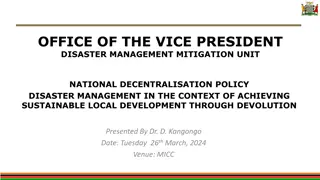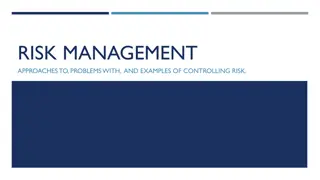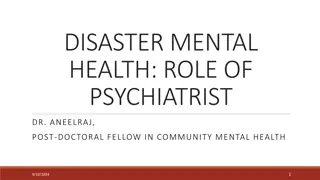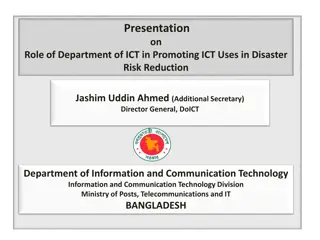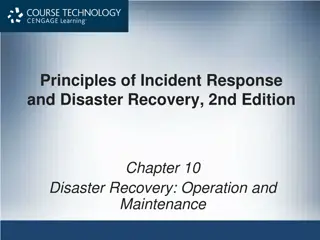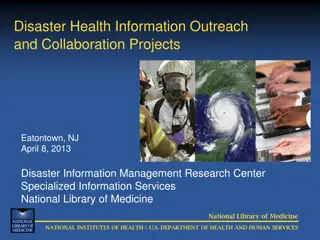Understanding the Five Phases of Disaster Risk Management
This presentation covers the five phases of Disaster Risk Management (DRM) which include Risk Prevention, Mitigation, Preparedness, Response, and Recovery. It explains the objectives and activities in each phase, emphasizing the importance of training in preparing for and responding to disasters effectively. The phases are not strictly distinct and often overlap, highlighting the dynamic nature of disaster management. Key activities such as risk identification, vulnerability reduction, and promoting resilience are discussed.
Download Presentation

Please find below an Image/Link to download the presentation.
The content on the website is provided AS IS for your information and personal use only. It may not be sold, licensed, or shared on other websites without obtaining consent from the author. Download presentation by click this link. If you encounter any issues during the download, it is possible that the publisher has removed the file from their server.
E N D
Presentation Transcript
Module 4 The Five Phases of DRM PPT 4.1
Module 4: Performance Objectives At the end of this Module, trainees will be able to: Explain the five phases of DRM strategy and the objectives of each phase List the activities that are required to be undertaken in each phase to face disasters effectively Explain the critical role that training plays in making employees understand their roles and responsibilities during disaster phases and to face disasters effectively PPT 4.2
Activities in this Module Go through the presentations Carry out an exercise to list the objectives and activities required to be undertaken in each phase of DRM for the highest-risk threat of the trainees administrations. Complete Progress Test Q 4.1 respective postal PPT 4.3
Five Phases of DRM Pre-disaster (i) Risk Prevention (ii) Mitigation (iii) Preparedness Post-disaster (iv) Response: 0 48 hours (v) Recovery: 48+ hours The phases are, however, neither very distinct nor they follow a typical cyclical pattern as in the diagram below. Activities in each phase often overlap PPT 4.4
The 5 Phases Preparedness Disaster Mitigation Risk Prevention Response Recovery PPT 4.5
Objectives and Activities in each phase of a Disaster PPT 4.6
1. Risk Prevention Objectives Activities 1. Prevent new and reduce existing disaster risks 1. Generating understanding of disaster risks through training and employee interactions 2. Reduce vulnerability to disaster hazard exposure and 2. Promoting a culture of disaster prevention, resilience and responsible corporate practices 3. Increase preparedness for response and recovery, thus strengthening resilience 3. Activities like periodical identification of disaster risks and using such information to organisation s investment policies, redesigning of buildings, supply chain, location of assets and facilities etc. that help in preventing disasters guide the PPT 4.7
2. Mitigation Objectives Activities 1. To eliminate occurrence of a hazard or emergency Broadly three types of activities: physical, socio-economic and environmental 2. To reduce the likelihood of occurrence (i) Physical Construction to reduce the effect of hazard event. For example, anti- seismic buildings 3. To reduce the damaging effects of unavoidable hazards Elevation/relocation prone to flooding of buildings Moving panels to higher floors in flood prone areas of generators/electrical PPT 4.8
Mitigation (contd.) Objectives Activities (i) Physical (contd.) Levees against flooding Relocation of vehicles to higher ground/floors Relocate electronic equipment and mail off the floors Window shutters for hurricane force winds Adopting more stringent building codes to improve disaster resistance of structures (known as Build Back Better or BBB measures) Insurance of assets and properties PPT 4.9
Mitigation (contd.) Objectives Activities (ii) Socio-economic: Coordination and cooperation with all stakeholders to exchange information on hazards, holding regular meetings. Helps clarifying roles of each stakeholder to face disasters (iii) Environmental: Establishment of early warning systems Resiliency of supply chain PPT 4.10
3. Preparedness Objectives Activities 1. To improve the capacity to respond rapidly and effectively, e.g.: 1. Establish an effective alert and early warning system among key individuals at all levels of the organisation through phone chain, telecommunication chain, text messages etc. What to do Where to go Whom to call 2. Set up Emergency Management Team (EMT) at HQ and in Field Units with clear role for team members. (Explained in detail on slides 4.14- 4.17) 2. To save lives and damage to assets, help response and rescue operations PPT 4.11
Preparedness (contd.) Objectives Activities 3. To keep a Business Continuity Plan (BCP) ready for continued performance of essential functions 3. Make staff aware of Postal 3P Status Report required to be sent to HQ (3P Report explained on slides 4.19- 4.20; Report Format in handout H 4.2) 4. Develop a viable Business Continuity Plan (BCP) to provide critical and essential services and to protect critical infrastructure. (BCP explained on slide 4.21) 5. Training and exercises (Covered in detail on slides 4.22-4.24) PPT 4.12
Preparedness (contd.) Objectives Activities 6. Relocate some establishments if the risk to continue from present location is very high 7. Emergency preparedness for organised personnel for monitoring, alert and evacuation, medical team, search and rescue operations, availability of food reserve, distribution of disaster supplies and equipments, emergency monetary fund PPT 4.13
Preparedness Setting up Emergency Management Team (EMT) This is set up to manage response & recovery activities effectively following a disaster Set up both at HQ and in Field Units Should consist of most senior managers of the organization like DG/PMG, Board Members, Heads of Divisions Each member of EMT has clear roles and responsibilities in their respective areas PPT 4.14
EMT at HQ Suggested Roles of Team Members DG/ PMG/ President Head of EMT Board Member(s) Deputy Head of EMT Senior most managers from: Postal Operations Resumption of postal operations Human Resources Well-being of employees Information Technology Maintenance of IT Network Finance Budgeting and expenditure management for response and recovery actions Facilities Assessment & Rehabilitation of facilities PPT 4.15
EMT at HQ Suggested Roles of Team Members (contd.) Disaster Risk Management Collection and analysis of all information/ reports from all Divisions Public Relations Production of press release General Affairs Communications with Government All Heads of Divisions Standardised report on 3P status Corporate communications Messaging to internal/ external stakeholders and maintenance of communication tools Other employees Reporting of own situation to respective Heads of Divisions PPT 4.16
EMT at Field Units Role of Team Members Postmaster/ Plant Manager/ Mail Processing Office In-Charge will head the team. Suggested role of team members: Postmaster/ Plant Manager/ Mail Processing Office In- charge Sending 3P Status Report to HQ (EMT); Evacuation; Resumption of service Other employees Report own situation to Postmaster or Plant Manager PPT 4.17
Emergency Operations Centre (EOC) EOCs are set up both at the HQ and in Field Units, whenever needed, to support assessment and communication efforts Such centres may have to work 24 hours in cases of serious disruptions All decisions and communications in EMT/ EOC should be recorded by a responsible person for their tracking and review in future. PPT 4.18
Preparedness 3P Status Report 3P Status Reports are prepared by Field Units and Heads of Divisions covering status of People, Property and Product on a day to day basis or even more frequently as necessary Field Units send their reports to HQ (EMT) All other employees, whether in HQ or field units, also send status reports covering their own situation to Heads of Divisions or Postmaster/ Plant Manager/ Mail Processing Office In-charge Format of 3P Status Report is at Hand Out H 4.2. PPT 4.19
Advantages of 3P Status Reports Use of a standardized situational report like 3P Status Report throughout all levels of the organization facilitates Assessment of impacts Prioritisation of assistance needed Work towards support in normalising operations PPT 4.20
Preparedness Business Continuity Plan (BCP) Each administration must develop a viable BCP to face any disaster A BCP i. Ensures successful disaster response and recovery operations ii. Identifies critical activities to be maintained after a disaster iii. Improves overall resiliency of administrations iv. Mitigates the strategic, stakeholder and financial impacts of a disruption v. Protects critical resources (facilities, equipment, records etc.) and personnel required for performing critical activities PPT 4.21
Preparedness - Role of Training & Exercises Objectives of Training & Exercises should be to reach the preparedness goals make employees understand their roles and responsibilities during a disaster respond correctly to disaster situations The Training Plan is a crucial part of the DRM Plan PPT 4.22
Role of Training & Exercises (contd.) Training should be conducted through lectures, seminars, workshops, drills, exercises etc. It should be progressive and utilise a building block approach, with training covering simple to complex situations and each exercise designed to build on the previous one. Diagram in next slide will explain this. Seminars, workshops, tabletop exercises, games, drills, functional exercises, full scale exercises are some training methods employed to train employees. PPT 4.23
Building Block Approach in Training Full-scale Exercises Functional Exercises Drills CAPABILITIES Games Tabletop Exercises Workshops Seminars COMPLEXITY PPT 4.24
4. Response (0 48 hours) Objectives Activities 1. To save lives 1. Search and rescue operations, evacuation 2. To prevent further damages to lives and assets secondary disaster (e.g., fire after earthquake, contaminated with raw sewage or toxic chemicals) from any 2. Employee accountability 3. Damage assessment flood waters 4. Temporary transportation communication restoration of and 5. Activate EMT both at HQ and in field units PPT 4.25
Response (contd.) Objectives Activities 6. Other emergency activities: Arrangement medical care for emergency Turning off gas valves Powering down equipments, if possible Moving tornado to basement during Taking cover and holding tight in an earthquake etc. PPT 4.26
Response (contd.) Objectives Activities 7. Response in 3P standardised report about people, property and product (Report Template distributed as handout H 4.2) 8. Activate EMT, BCP 9. Secure safety of employees, customers, vendors, contractors 10. Prevent secondary or collateral damage PPT 4.27
Response (contd.) Objectives Activities 11. Secure postal equipments and infrastructure, vehicles 12. Conduct initial damage assessment (postal administrations can ask for ESF from UPU to restore most basic postal services) 13. Consider embargo of mail destined to damaged facilities 14. Notify employees and customers of closed facilities PPT 4.28
Response (contd.) Disaster Response is the implementing phase of the Disaster Preparedness step The focus in this phase is on saving lives, meeting the basic needs of the people until more permanent and sustainable solutions can be found PPT 4.29
5. Recovery (48+ hours) Recovery is the implementation of actions to promote sustainable redevelopment following a disaster Consists of Rehabilitation Reconstruction and Repairs Long term assistance to rebuild PPT 4.30
Recovery (contd.) Objectives Activities 1. To return to a normal or an even safer situation after the disaster 1. Immediate recovery activities: Disaster debris clear up 2. To resume normal postal Relocation of facilities to a safe site/ in temporary tent/ operation through units operations mobile Resumption activities of critical 2. Temporary repairs of buildings PPT 4.31
Recovery (contd.) Objectives Activities 3. An assessment of damage to postal facilities and an evaluation of status of critical infrastructure (electricity, water, roads, facilities at airport etc) 4. Replacement of damaged equipment 5. Rebuilding of damaged facilities adopting Build Back Better (BBB) process PPT 4.32
Emergency Procedure Checklists to Face Disasters Will be covered in detail in Module 7 later. Such checklists are also known as DRM tools and products These checklists have been developed out of industry best practices and should be followed by postal operators both in pre-disaster and post- disaster phases Helps to face disasters effectively Each postal administration is required to customise these checklists to suit their own requirements PPT 4.33
Exercise to list Objectives & Activities for the top-risk threat of trainees administrations Trainees have already identified the high-risk threats (in High Risk High Impact zone) of their administrations from Risk Grid Now select the threat with the highest risk List the objectives and activities required to be undertaken in each phase of DRM to face this highest-risk threat as a sample exercise [Use Handout H 4.3 for this] PPT 4.34
Progress Test Q 4.1 PPT 4.35







